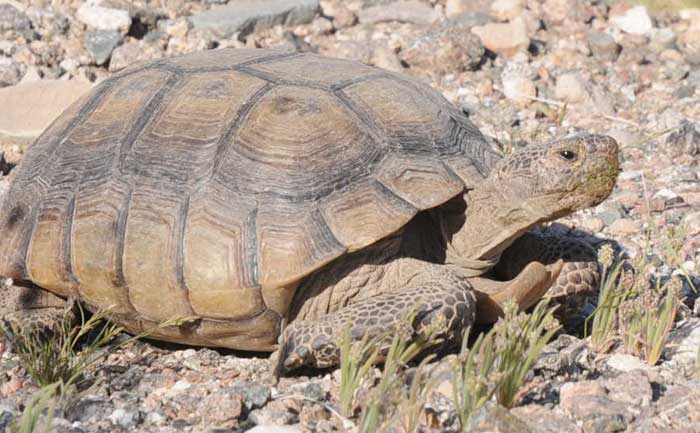Desert Tortoise Council Symposium 2020
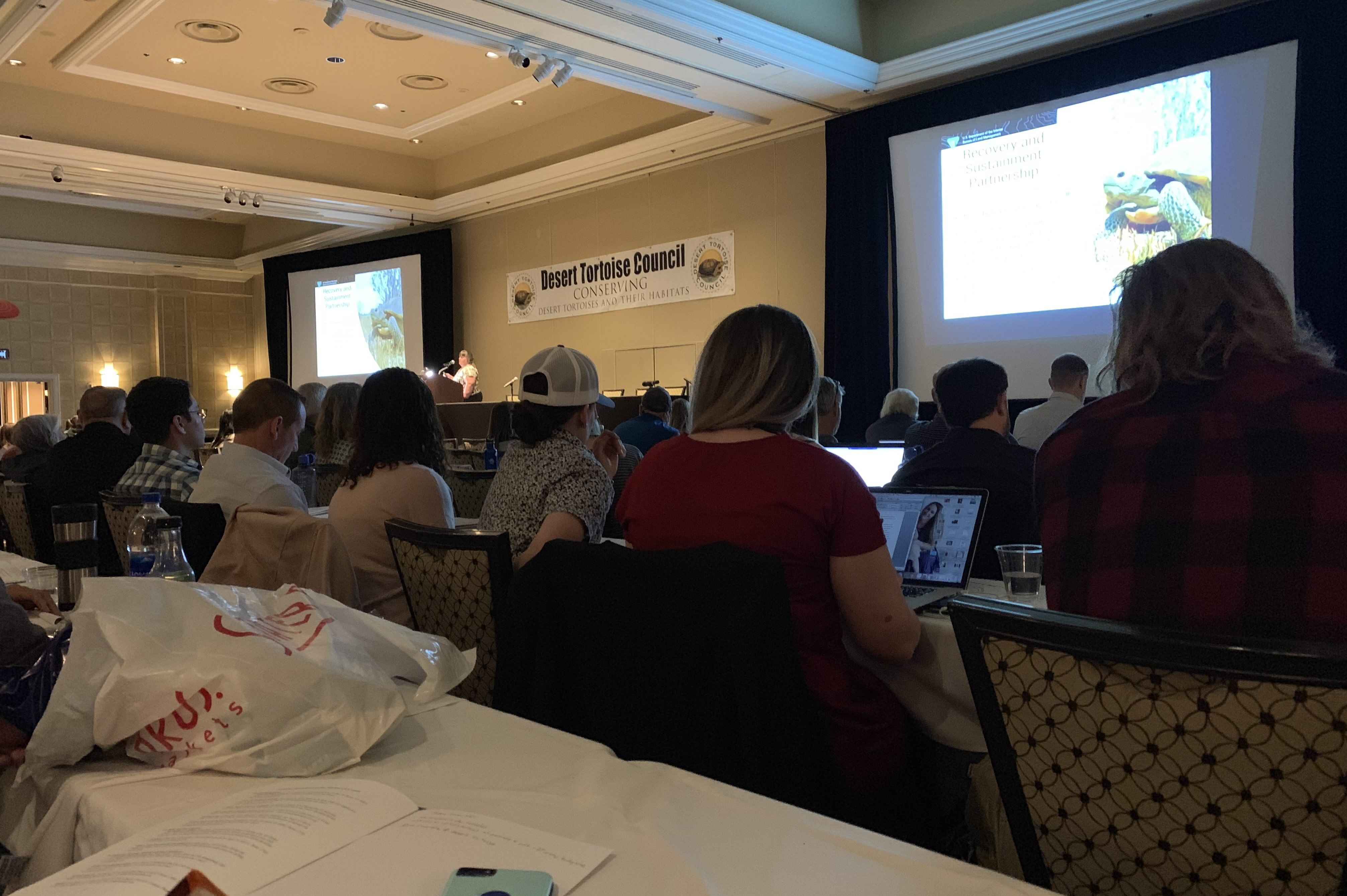
February 22, 2020 - Las Vegas NV - Basin and Range Watch tries to attend every symposium on desert tortoises hosted by the Desert Tortoise Symposium (even when we were snowed out in Kingman in 2019 and never made it!).
This year we noticed a consulting company lift one of our photos to use in its sales sheet on tortoise monitoring gear at a vendor table. We do not appreciate this and let the company know they need to remove our photo. They had not asked permission, and we take copyright infringement of our photos seriously.
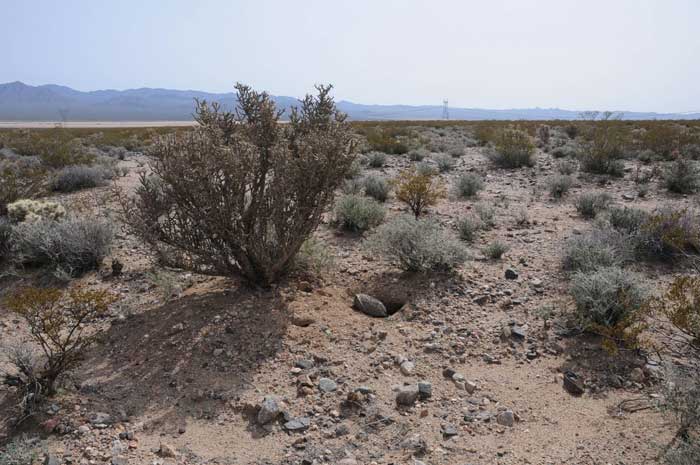
Adult female Mojave desert tortoise at her burrow next to a tall pencil cholla in 2011, found in Ivanpah Valley CA on the future site of the Stateline Solar Project--this scene is now gone, full of photovoltaic panels. Photo by Laura Cunningham Copyright 2020. Do not use without permission.
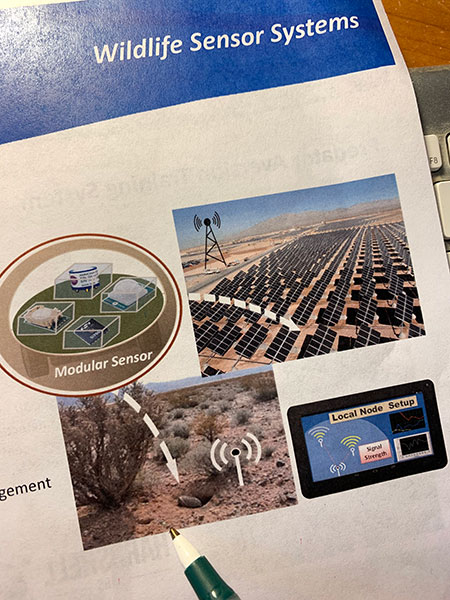
^Copyright infringement of the use of our photo, lifted from the Basin and Range Watch website, by a private company selling wildlife monitoring equipment.
Some highlights of the conference:
The agencies spent a session discussing the latest threats to the desert tortoise, including road mortality and raven predation. Studies on the best exclusion fences to line highways, and culverts to allow tortoises to pass under roads, were discussed. Raven management was also explored, including increasing use of egg-oiling, where vegetatble oil is used to spray raven eggs in nests, supphocating the eggs and helping to reduce the raven populations that has exploded in the California Desert.
Seed collection, and vertical mulching on off-road incursions were mentioned as a way to reduce habitat damage to Areas of Critical Environmental Concerns (ACECs).
Sahara mustard and other invasive plants are a huge and growing problem, with hand-pulling and local herbicide application as a few ways to deal with the problem.
Yet strangely there was no discussion of the gigantic threat of large-scale solar projects to the desert tortoise.
Vincent James of the U.S. Fish and Wildlife Service said that rangewide surveys were ongoing, and several critical habitat units were surveyed using line distance sampling in 2019. Several more were scheduled to be surveyed in 2020.
Researcher Brian Wallace related that although about 60% of Mojave desert tortoise habitat is on land managed by the Bureau of Land Management (BLM), BLM still does not have a cohesive management strategy across all field offices.
Dr. Kristin Berry of the U.S. Geological Survey, discussed questions of diseases in desert tortoises: Ivanpah Valley shows more pneumonia symptoms in tortoises, but the population is top-heavy with adults. There are very few juveniles and young adults, possibly from the two large transmission lines that pass over the desert here, serving as nest and perch sites for raven predators. Meanwhile in Goffs and Fenner valley, shell disease is more prevalent, a metabolic disorder that could be a legacy of World War II military activity in the area from the rail and roads. Toxins could still be in the soil and plants.
Frances Origgi from the University of Bern, Switzerland, discussed how testudine herpesviruses and their tortoise hosts are usually in equilibrium, having co-evolved over time. But the environment is incredibly important--when stressors such as drought and toxins disturb this equilibrium and the immune system of tortoises is overwhelmed, the disease comes out and tortoises become symptomatic and sick.
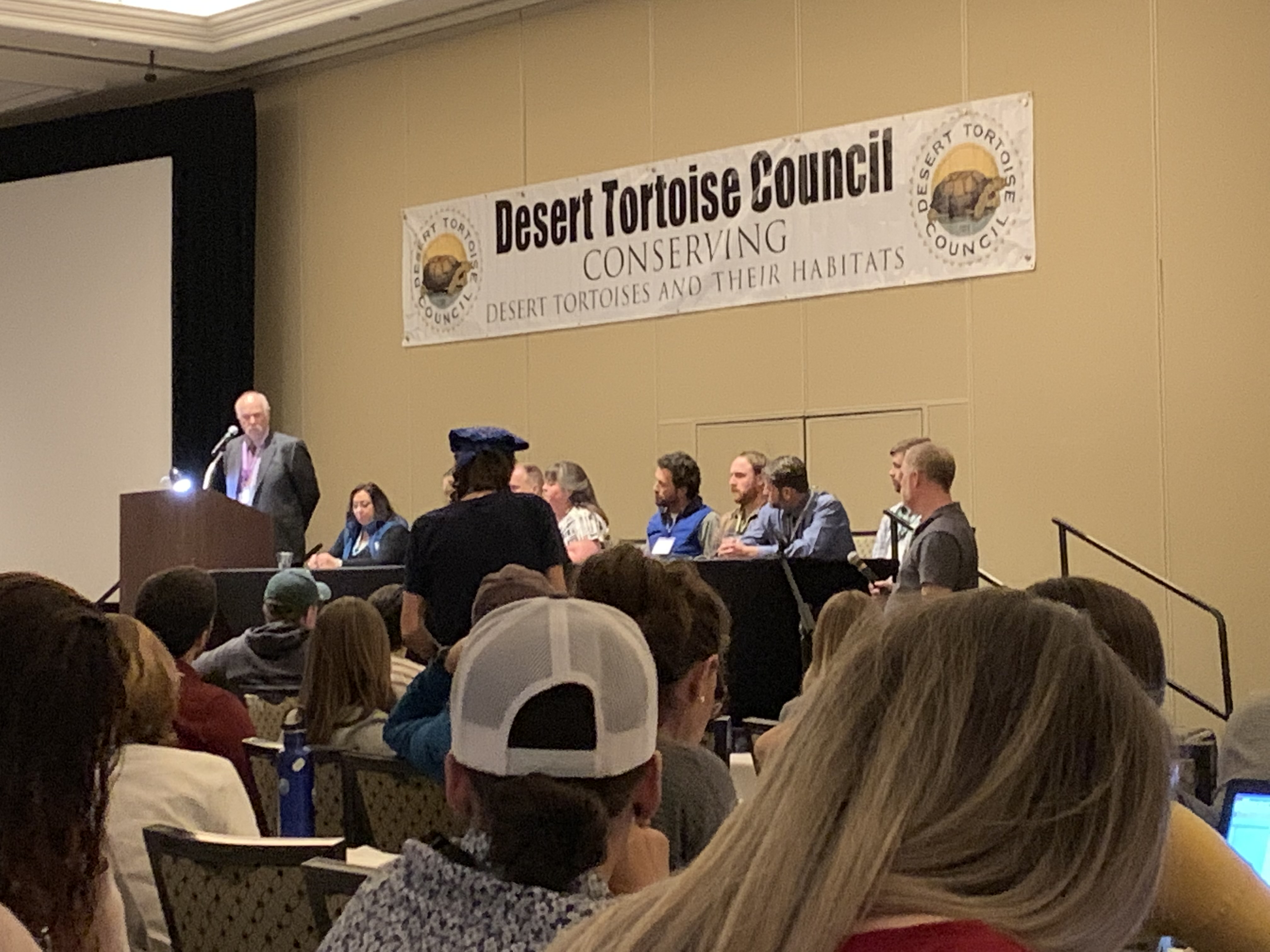
^Panel discussion.
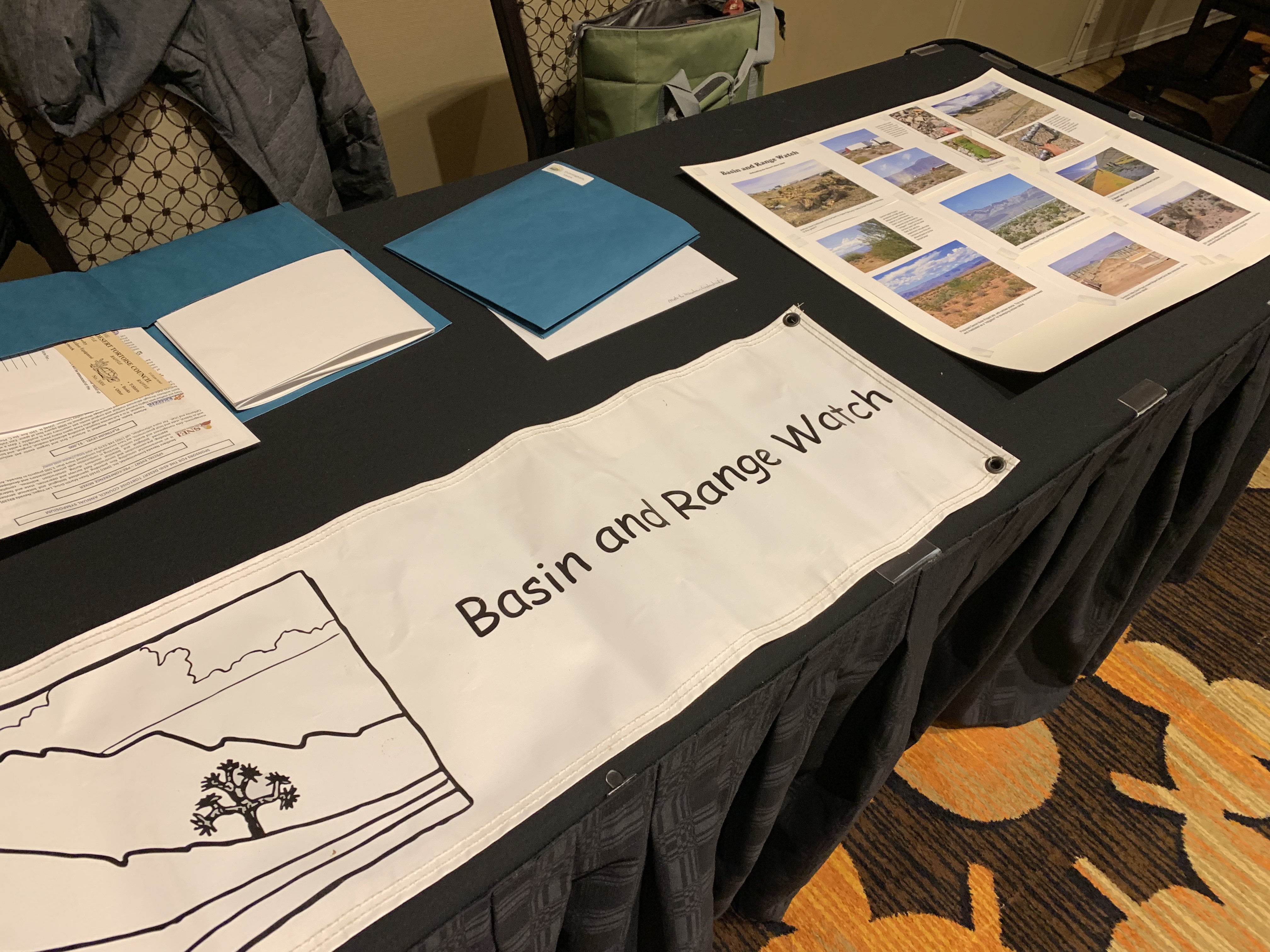
^Basin and Range Watch educational table at the Desert Tortoise Council Symposium.
Tortoise West of Colorado River Unique; Tortoise East of River Made New Species
^The Desert tortoise now becomes the Mojave desert tortoise, or Agassiz's desert tortoise.
June 28, 2011 -
In a major scientific analysis of the Desert tortoise (Gopherus agassizii), tortoise biologists and geneticists split the species into two species after carefully looking at DNA samples. The Sonoran Desert Tortoise is split off from Mojave Desert Tortoise, and given a new name, Gopherus morafkai.
Since the Mojave desert tortoise is found to actually be restricted to such a limited area, it warrants even more protection. Calls for raising the level of federal protection from Threatened to Endangered status may be needed, in the face of large-scale solar project habitat destruction, military base expansions, diseases, off-road activity, poaching, and predation by subsidized ravens, coyotes, and feral dogs increasing.
Sonoran desert tortoises differ substantially from tortoises in the Mojave Desert. In general, Sonoran tortoises live in rock crevices on steep slopes and hill tops in Arizona upland desert, palo verde-saguaro cactus desert, thornscrub, and desert grassland; and Mojave desert tortoises live in burrows in valleys and on alluvial fans in saltbush scrub, creosote bush scrub, Mojave desert scrub, and tree yucca woodland.
The authors recommend that the Mojave desert tortoise be called Agassiz's desert tortoise because it is found within the Sonoran Desert west of the Colorado River in California; the new species east of the Colorado River can be called Morafka's desert tortoise, as it occurs in the Sonoran Desert in Arizona but also a small area of the Mojave Desert in western Arizona. It also occurs in Sinaloan Thornscrub in Mexico.
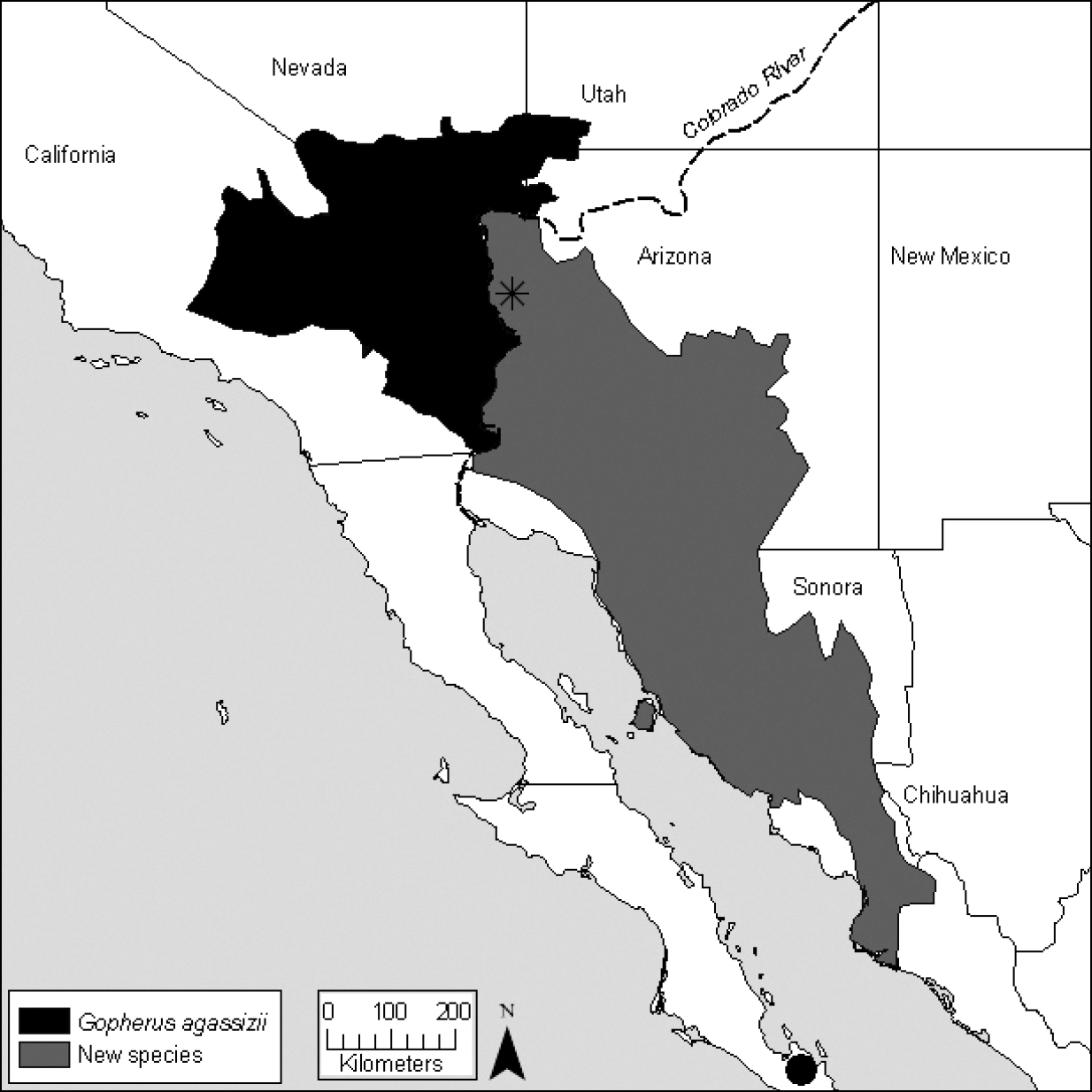
^Map showing the range of the two species of tortoise on either side of the Colorado River.
Differences in microsatellite DNA alleles and maternal mitochondrial DNA were used by Murphy and other researchers to separate out more than one species in the desert group of tortoises. The two forms have been separate for apparently as long as 5-6 million years, and only hybridize in one small area in western Arizona.
Other differences include a much wider and box-like shell and longer gular scutes in the Mojave, while the Sonoran tortoise has a narrower, flatter pear-shaped shell. Mojave tortoises lay 5-16 eggs from April to mid-July, while Sonoran tortoise deposit on average 5 (1-12) eggs from early June to early August, associated with monsoonal rains. Mojave tortoises may have as many as 3 clutches per season, Sonoran only one every 1-2 years. Female Mojave tortoises become reproductively active at 176-178 millimeters carapace length, while Sonoran tortoises lay their first eggs at 220 mm carapace length.
A very high number of captive tortoise are hybrids.
The authors are examining the Morafka's desert tortoise in the far southern edge of its range in Sinaloan Thornscrub habitat in Mexico, as this population may be a third cryptic species of tortoise.
The Paper:
The dazed and confused identity of Agassiz’s land tortoise, Gopherus agassizii (Testudines, Testudinidae) with the description of a new species, and its consequences for conservation, by Robert W. Murphy, Kristin H. Berry, Taylor Edwards, Alan E. Leviton, Amy Lathrop, and J. Daren Riedle. ZooKeys 113: 39–71, doi: 10.3897/ZooKeys.113.1353. Published 28 June 2011
http://www.pensoft.net/J_FILES/1/articles/1353/1353-G-1-layout.htm
From the paper:
The most important implication of describing Gopherus morafkai is that Arizona and Mexico can no longer be considered to harbor a genetic reservoir for the Mojavian population of the desert tortoise, now exclusively defined as Gopherus agassizii. The recognition of Gopherus morafkai reduces the geographic range of Gopherus agassizii to about 30% of its former range (Van Devender 2002, Fig. 1.2); Gopherus agassizii now occupies an estimated 83, 124 km2 of habitat (Fig. 2, also see model in U.S. Dept. of the Interior, Fish and Wildlife Service 2010a). Gopherus agassizii, which can now be referred to as Agassiz’s desert tortoise, has suffered tremendous population declines in the past 30 years (U.S. Dept. of the Interior, Fish and Wildlife Service 1994, 2010a). And much of the Mojave Desert does not offer habitat suitable for Gopherus agassizii (Hagerty et al. 2011). The taxonomic reduction of the species’ distribution can have dire consequences. Whereas species with broad distributions may survive population declines, those that have small distributions are far more likely to become extinct (MacArthur and Wilson 1963, 1967; Gilpin and Soulé 1986; Saccheri et al. 1998; O’Grady et al. 2006). Agassiz’s desert tortoise, currently listed as threatened under the Endangered Species Act of 1973 (as amended) (U.S. Dept. of the Interior, Fish and Wildlife Service 1990), may require a higher level of protection to ensure the level of management that would maximize its chances of survival.
A Recovery Plan was prepared for the Mojavian population (Agassiz’s desert tortoise) in 1994 (U.S. Dept. of the Interior, Fish and Wildlife Service 1994). Six recovery units were described in this Recovery Plan in an effort to capture ecological and genetic variation. The writers of the Recovery Plan also noted evidence of important ecological substructuring within the Western Mojave Recovery Unit, the largest and most heterogeneous of the recovery units in terms of climate, vegetation and topography (U.S. Dept. of the Interior, Fish and Wildlife Service 1994). In an analysis of genetic differences within the Mojavian population, Murphy et al. (2007) confirmed that genetic substructuring existed within the Western Mojave Recovery Unit, with boundaries similar to those described in the 1994 Recovery Plan for western, central, and southern regions. The boundaries followed a major river, the Mojave River, as well as other climatic and ecological differences. Hagerty et al. (2011) confirmed the pattern reported by Murphy et al. (2007), although Hagerty and Tracy (2010) speculated that patterns reported by Murphy et al. (2007) were due to sampling bias. We think that the new genetic information from Murphy et al. (2007) and Hagerty et al. (2011) provide important support for updating recovery planning in the future.
....
The recognition of Gopherus morafkai is likely to hasten federal listing of the new species, Gopherus morafkai, in the USA. The Mojave population can no longer be considered to be a genetic reservoir for Gopherus morafkai or vice versa, and, unfortunately, the hybrid ex situ population involves a significant portion of tortoises presumed to be Gopherus morafkai (Edwards et al. 2010). These hybrids involve not only Gopherus agassizii but also Gopherus berlandieri. The genetic integrity of Gopherus morafkai may now be threatened by intentional release and escape of captive hybrids. As noted previously, natural hybrids occur in a limited portion of northwestern Arizona where Mojave and Sonoran ecosystems interdigitate (McLuckie et al. 1999). The hybrid zone appears to occur only in this area (Fig. 2). Little is known about the effects of hybridization on the native population, a topic that deserves attention. Adding to the concerns, Gopherus morafkai may contain two cryptic taxa in Mexico (Lamb et al. 1989). All species and populations in both Mexico and the USA would benefit from aggressive conservation action because of the potential for additional cryptic species in Mexico.
...
Given drastic population declines in Gopherus agassizii during the past few decades, it might be endangered.
Press Release - Rockin’ Tortoises: A 150 Year Old New Species
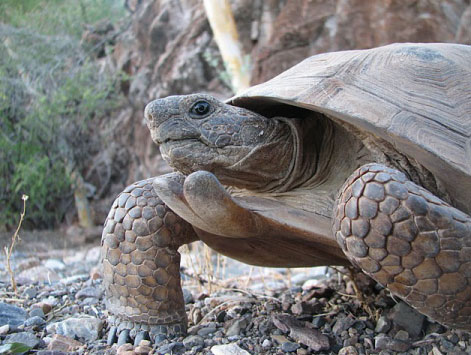
^Sonoran Desert tortoise (Gopherus morafkai) from Tiburon Island, Sonora, Mexico (photo courtesy of Taylor Edwards, 2010).
A team of researchers investigated the identity of desert tortoise of the Southwest USA
and northwestern Mexico. What was thought to be a rather simple problem in species
identification turned out to be very complex. Their investigations involved forensic
genetics and other methods. In the end, they found it necessary to describe a new species.
More than a species description, the discovery has very important implications for
conservation and the development of the deserts of southern California.
Since the original description of Agassiz’s Land Tortoise, scientifically called Gopherus
agassizii, facts have been nothing less than Dazed and Confused. One hundred fifty years
ago, in 1861, James Graham Cooper described a new species of tortoise from the deserts
of California. From the get-go, factual confusion has been more common than not. The
publication date has consistently been inappropriately attributed to 1863, and even the
original common name, Agassiz Land Tortoise, was inexplicably changed to the Desert
Tortoise, a moniker that is commonly used today. But there’s more than just a new name.
For 150 years, Agassiz’s Land Tortoise has been masking the existence of at least two
species whose distributions are restricted to either side of the Colorado River. Prof. Bob
Murphy of the Royal Ontario Museum, Toronto, Canada and the Kunming Institute of
Zoology, Chinese Academy of Sciences, and colleagues from the US Geological Survey,
Arizona Research Laboratories, California Academy of Sciences, and Lincoln University
have now started to unravel a Gordian knot. As if coming straight out of an episode of
the TV series CSI, they went into the laboratory and obtained DNA data from the original
150-year-old type specimen, as well as from a more recently described species inhabiting
the tip of the Baja California peninsula. The effort in forensic genetics documented
that the named species was from California, and not Arizona as sometimes claimed.
The enigmatic species from Baja California was previously thought to be a transplant
from Tiburon Island, Sonora, Mexico, but turns out to be from California, or at least its
founding mother was from there. All of this meant that the population in Arizona and
adjacent Mexico was an unnamed, new species, one whose identity had been hidden for
more than a century.
The new rock-dwelling species, Gopherus morafkai, is named for the late Prof. David J.
Morafka, a pioneer in tortoise research. The results of the research are published in the
open access journal ZooKeys.
More than a species description.
The recognition of Morafka’s Desert Tortoise means that Agassiz’s Desert Tortoise
has lost a whopping 70 percent of its range! Arizona and adjacent Mexico can no
longer serve as a genetic reservoir for the Western species. And given that the Western
species was already listed as being threatened because of drastic decline in the number
of individuals—a consequence of disease, urban expansion and habitat destruction—
the description of the new species may turn up the heat on politicians and developers
with respect to the massive construction of solar energy sites in prime Desert Tortoise
habitat in the Mojave Desert. Perhaps this flagship centurion of the Southwest should be
upgraded to Endangered status? Because Morafka’s Desert Tortoise has lost 30% of its
range, perhaps protection for this species should be fast-tracked? Only time will tell.
The complete story remains untold. The knot remains untied. It is possible that Morafka’s
Desert Tortoise may consist of two species. And so, back to the field and lab goes the
team, inspired by knowing that Dave Morafka would be very pleased with the progress.
Reaction to the New Species Description
See articles with interviews from tortoise experts in the Desert Dispatch -http://www.desertdispatch.com/news/desert-11140-mojave-separate.html
Mickey Quillman, chief of resources for the Barstow Bureau of Land Management office, said that if a new species was designated, the BLM would have to be careful not to translocate tortoises too far away from where they were originally found — moving tortoises less than 20 miles away compared to 50 miles away. “We want to keep the same genetic population close to where it was found,” he said.
From the Hi-Desert Star - http://www.hidesertstar.com/articles/2011/06/29/features/doc4e0a957116400880654521.txt
“The two species have different habitat preferences,” Dr. Kristin Berry, a USGS biologist who has studied desert tortoises for more than 40 years, said. “Morafka’s tortoise prefers to hide and burrow under rock crevices on steep, rocky hillsides, while the Agassiz’s tortoise prefers to dig burrows in valleys.”
Dr. David Morafka
The authors of the new species description say, "the new species is a patronym for the late Professor David Joseph Morafka in recognition of his many contributions to the biology and conservation of the species of Gopherus and his unsurpassed way of facilitating research, even among researchers with very different perspectives."
Members of Basin and Range Watch have worked extensively with Dr. Morafka on projects involving the Panamint alligator lizard and Mojave fringe-toed lizard, as well as tortoise and other reptile species. We are honored to have worked with him and learned from his encyclopedic knowledge base. He was a biogeographer at heart, and a conservationist in practice, who took on the challenge of genetics with a passion, applying the latest research from the laboratory to interesting questions on the field involving questions of why certain species occupied Sky Island mountain ranges in the desert, integrating questions of paleontology and ecology, and theorizing how complexes of species evolved through time on changing landscapes. He brought a breadth and depth of biological and geological knowledge to all his discussions, and was always interesting to be in conversation with. We regret his early passing, as he had so much work to do studying the complex and interesting biogeography and paleo-ecologocal history of the Southwest.
